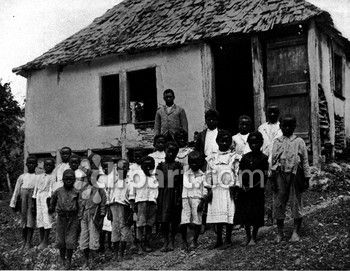Clinton Grove ES History
In the 1998 issues of the PL HUG, we began a series of articles about the beginnings of what is now known as Clinton Grove Elementary School. Much of this information has been gathered from a book entitled Records and Recollections: Early Black History in Prince George's County, Maryland by Bianca P. Floyd and published by the Park and Planning Commission. This book can be obtained at the Surratt House in Clinton, Maryland.

August, 1867
Clinton Grove Elementary School began life in 1868 as the Robeystown School No. 1, District 9. It was the first school established for the African-American community in the Surrattsville-Clinton area. It was established to provide education to the children of freed slaves by the Freedmen's Bureau. This was done at a time when there was not strong support for the education on these children.
The construction of the school began in August of 1867, after the land was "given" to the Freedmen by Townley B. Robey, a white farmer. Freedmen was suppose to provide money for the school's support. In actuality, the land was purchased by the Freedmen's Bureau and deemed to the trustees. Two hundred dollars was provided for the construction of the school and the finished building measured 18 feet by 32 feet. It was located on the property now occupied by the American Legion Hall on Piscataway Road.
There were many difficulties in opening and running the school. Failure to support the school when the trustees tried to solicit the remainder of the final four hundred dollars cost caused delays in opening the school for the children. In fact, many of the better off families refused to send their children to the school, opting instead for the Bureau School in Oxon Hill or Niles Chapel.
December, 1868
It was not until between the end of November and the beginning of December of 1868 that a teacher was selected and directed to open the school. That teacher was Martha J. Smith. She was also directed to organize a school organization among Freedmen Organization who were to select five men to serve as trustees for the school. Controversy continued between the trustees and Robey to the point where it was suggested that school matters be taken out of Robey's hands.
The First Teacher
Martha Smith was the first teacher at the old Robeystown School. She was directed by Rev. Kimball to organize a school association among the Freedmen and have them select five men to serve as the trustees. It was his intent, if this meeting was successful, to pay for both the school and to deed it to the Freedmen. Rev. Kimball also praised Martha Smith, stating that the Freedmen's Bureau could not have found a better "colored" teacher. Apparently this meeting was the best that had been held since the school house was built.
The "Poorest Concern"
Miss Smith continued her efforts to work with Mr. Robey and the trustees while also running the school. On February 8, 1869, John Butler, a Freedmen's Bureau representative, visited the schools and reported afterwards to Rev. Kimball that this was the "poorest concern I have come upon in all my travels." It was the feeling that Miss Smith was exerting all of her powers to make the school into a success despite Mr. Robey's interference. The community agreed with Mr. Butler's evaluation and stated that its desire to "determine and direct their own affairs were thwarted by the control Robey exerted over the school.
Ultimately, Mr. Robey sent Rev. Kimball the deed and two bills for school construction. These were sent to Miss Smith to be given to the trustees. Mr. Robey insisted that the school yard be fenced in.
End of Interference
The concerns regarding the Robeystown School involving interference by Mr. Robey and failure to pay the final bills for construction. These issues were finally resolved when Mr. Robey finally sent the deed and the two bills.
May, 1869
On May 5, 1869, Rev. Kimball directed that the school be closed in July, and that the teacher, Miss Smith, should continue to receive her salary but not room and board. It this was not acceptable, she could, and did, close the school earlier and return to Philadelphia.
The next teacher was a man who remained only one month. After several more teachers came and went, Mrs. Mary Ferguson, a white woman from the area applied for the position. She was hired and the Freedmen's Union Commission agreed to pay her a salary provided that her school had no fewer that thirty students. She too experienced the negative sentiments of the community toward "colored" schools. Mrs. Ferguson taught at the schools through the fall of 1870.
It is unclear who requested the removal of Mrs. Ferguson from the teaching position at Robeystown School. There is no record of who held that position from 1871 until the hiring of Rosa E. Cannon until 1873. She had better tenure at the school, remaining until 1877.
August, 1878
The school had originally been built on land that had been part of the Surratt Farm. In August of 1878 a deed to the land was granted to the Board of School Commissioners. The building was similar to other Bureau schools in that it was a one-room frame structure. The original building remained in use until 1929, when it was replaced by a concrete structure.
January, 1925
The old building was not replaced without controversy and argument. Beginning in January of 1925, patrons of the Clinton Colored School No.1, District 9, formally the Robeystown School, began petitioning for a new building. The first petition was refused, although the building had been in use for 58 years. In January of 1926 the board agreed to replace the building after the patrons offered to raise five hundred dollars towards its construction. The board authorized construction including $2,200 in the budget for the new school. The new building was completed in 1929 and remained in use until the 1950's, when it was sold to the Clinton American Legion Post #249 for $43,000.
The new school, for two hundred students, was built on a farm in the Clinton Grove area, where it remains today with modifications made to it in the 1970's to accommodate six hundred students.
We hope you have enjoyed this history of the school. It is one of the oldest schools in Prince George's County, and its students should know about its history.
